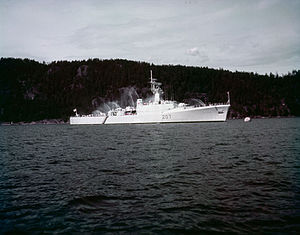HMCS Skeena (DDH 207)

HMCS Skeena (DDH 207) in 1957
|
|
| History | |
|---|---|
|
|
|
| Name: | Skeena |
| Namesake: | Skeena River |
| Builder: | Burrard Yarrows, Vancouver |
| Laid down: | 1 June 1951 |
| Launched: | 19 August 1952 |
| Commissioned: | 30 March 1957 |
| Decommissioned: | 1 November 1993 |
| Reclassified: | 14 August 1965 (as DDH) |
| Homeport: | Halifax, Nova Scotia (as DDH) |
| Identification: |
|
| Motto: | "En Avant" |
| Honours and awards: |
Atlantic 1939–44, Normandy 1944, Biscay 1944 |
| Fate: | Scrapped in 1996. |
| Badge: | Azure, out of a base invected argent, a salmon sinisterwise proper |
| General characteristics | |
| Type: | St. Laurent-class destroyer escort |
| Displacement: |
|
| Length: | 366 ft (111.6 m) |
| Beam: | 42 ft (12.8 m) |
| Draught: |
|
| Propulsion: | 2-shaft English-Electric geared steam turbines, 3 Babcock & Wilcox boilers 22,000 kW (30,000 shp) |
| Speed: | 28.5 knots (52.8 km/h) |
| Range: | 4,570 nautical miles (8,463.6 km) at 12 knots (22.2 km/h) |
| Complement: |
|
| Sensors and processing systems: |
|
| Electronic warfare & decoys: |
|
| Armament: |
|
| Aircraft carried: |
|
| Aviation facilities: |
|
HMCS Skeena was a St. Laurent-class destroyer that served in the Royal Canadian Navy and later the Canadian Forces from 1957–1993. Skeena was constructed as a destroyer escort and was converted in the 1960s to a helicopter-carrying destroyer. In 1972, the ship was designated a French Language Unit, the second in Canadian service. Discarded in 1994, the ship was broken up in India.
The need for the St. Laurent class came about in 1949 when Canada joined NATO and the Cold War was in its infancy. The Royal Canadian Navy (RCN) was assigned responsibility for anti-submarine warfare (ASW) and controlling sea space in the western North Atlantic. The St Laurent class were built to an operational requirement much like that which produced the British Type 12, and were powered by the same machinery plant. The rounded deck-edge forward was adopted to prevent ice forming. The vessels were designed to operate in harsh Canadian conditions. They were built to counter nuclear, biological and chemical attack conditions, which led to a design with a rounded hull, a continuous main deck, and the addition of a pre-wetting system to wash away contaminants. The living spaces on the ship were part of a "citadel" which could be sealed off from contamination for the crew safety. The ships were sometimes referred to as "Cadillacs" for their relatively luxurious crew compartments; these were also the first Canadian warships to have a bunk for every crew member since previous warship designs had used hammocks.
As built, the ships were 366 feet (112 m) long overall with a beam of 42 feet (13 m) and a draught of 13 feet 2 inches (4.01 m). The destroyer escorts displaced 2,263 tonnes (2,227 long tons) standard and 2,800 tonnes (2,800 long tons) at deep load. The destroyer escorts had a crew of 12 officers and 237 enlisted.
...
Wikipedia
